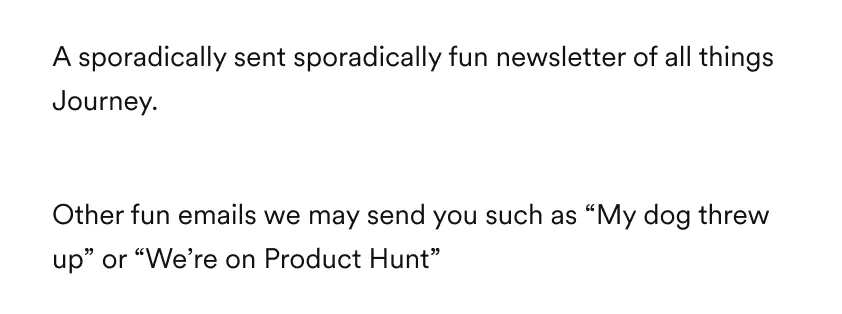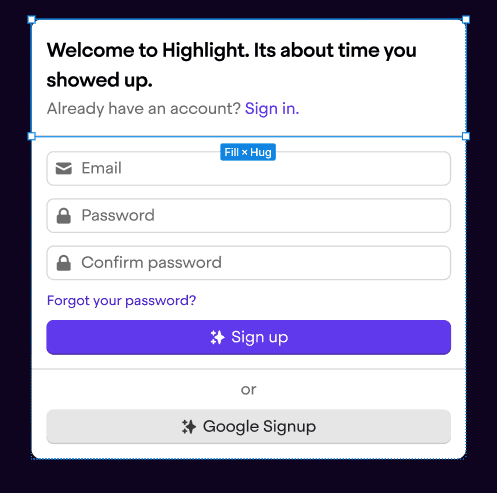Back
Back
With copy, Think Different not Differently
With copy, Think Different not Differently
Nov 9, 2022


Apple makes great products that take months and years of hard work. Apple also puts as much effort, emphasis and care into the quality of the words (and grammar!) that they use to talk about it’s products.
Every product on the Apple homepage has a delightful subheading:
iPhone 14 Pro → Pro. Beyond.
Apple Watch Ultra → Adventure Awaits.
Apple TV 4K → The Apple experience. Cinematic in every sense.
iPad → Lovable. Drawable. Magical.
Apple doesn’t start by talking about it’s products in sentences and paragraphs — they just use a couple of impactful profound words. Does describing an iPad as “loveable” tell you why the product is loveable? Of course not — but it stands out and grabs you. It makes you want to learn why they said that.
Apple takes it’s thoughtfulness about words to degrees that few other companies do. For example, Apple doesn’t like it’s products to be pluralised:
@Gartenberg @BenedictEvans @stevesi @macintux One need never pluralize Apple product names. Ex: Mr. Evans used two iPad Pro devices.
— Philip Schiller (@pschiller)April 28, 2016
Business Insider described Apple’s deft hand with words as “atrocious and cunning”:
Apple refers to its products grammatically as persons and not as objects. If Steve Jobs is talking about an iPod, an iPhone or an iPad, he will say "iPhone does this" or "iPad does that", instead of "the iPhone does this" and "the iPhone does that." You would use the former version to refer to a person, and the latter to an object.
It's extremely smart because it's so subtle. We'll bet most people haven't noticed it. And yet it's exactly the kind of thing that works. It sends a bunch of powerful subliminal messages about Apple. Our products are unique and very valuable. Perhaps as importantly: We don't speak about our products in the same way as our competitors.
You could even argue that the original Apple slogan, “Think Different” is grammatically incorrect…
Now, I am not suggesting that you create multiple Journey experiences (although that doesn’t sound half fancy) but this is a great example of Apple being incredibly thoughtful and conscious about the words they use.
Be fun everywhere
When I was designing our email management screen — easily the most boring and uninspiring page that almost all companies have to eventually build — I couldn’t resist just writing some fun copy.

Why? Well why not? Writing that copy amused me, hopefully when someone else is in the bowels of Journey settings, they’ll notice this copy and also think it’s mildly amusing. And if no one does — who cares? It has cost nothing, cost zero additional development or design time — it’s just words.
But be especially fun with marketing


Here’s a great example — isn’t the second design way more fun and engaging than the first one? It’s just fun and quirky and in a world of drab SaaS products begging you to signup, why not try and inject a little personality?
Three tips to write good copy
Just write things. Do not overthink or attempt to get a consensus. If one person thinks copy is amusing and another person shrugs: just ship it! Writing copy is like writing jokes, it’s better to do it solo.
Be consistent but not overboard. Not every button, heading and paragraph needs to be rip roaring — in fact, please do not do this! — but at the same time, you shouldn’t only have your email settings be quirky and the rest of your product feel like a stately home. Thread the needle and ensure you have a consistent voice that is simply amplified occasionally, and subdued most of the time.
Iterate! These are just words. There is nothing more satisfying than shipping a header, changing it to something fun a few days later, and then a week later mixing it up. Again — they’re just words. Just swap things in and out until they really resonate and hum with you.
In summary: write the copy you want to read in the world
At the end of the day, just write and ship copy that you want to read. Keep the vision, voice and tone simply — write something you like!
Apple makes great products that take months and years of hard work. Apple also puts as much effort, emphasis and care into the quality of the words (and grammar!) that they use to talk about it’s products.
Every product on the Apple homepage has a delightful subheading:
iPhone 14 Pro → Pro. Beyond.
Apple Watch Ultra → Adventure Awaits.
Apple TV 4K → The Apple experience. Cinematic in every sense.
iPad → Lovable. Drawable. Magical.
Apple doesn’t start by talking about it’s products in sentences and paragraphs — they just use a couple of impactful profound words. Does describing an iPad as “loveable” tell you why the product is loveable? Of course not — but it stands out and grabs you. It makes you want to learn why they said that.
Apple takes it’s thoughtfulness about words to degrees that few other companies do. For example, Apple doesn’t like it’s products to be pluralised:
@Gartenberg @BenedictEvans @stevesi @macintux One need never pluralize Apple product names. Ex: Mr. Evans used two iPad Pro devices.
— Philip Schiller (@pschiller)April 28, 2016
Business Insider described Apple’s deft hand with words as “atrocious and cunning”:
Apple refers to its products grammatically as persons and not as objects. If Steve Jobs is talking about an iPod, an iPhone or an iPad, he will say "iPhone does this" or "iPad does that", instead of "the iPhone does this" and "the iPhone does that." You would use the former version to refer to a person, and the latter to an object.
It's extremely smart because it's so subtle. We'll bet most people haven't noticed it. And yet it's exactly the kind of thing that works. It sends a bunch of powerful subliminal messages about Apple. Our products are unique and very valuable. Perhaps as importantly: We don't speak about our products in the same way as our competitors.
You could even argue that the original Apple slogan, “Think Different” is grammatically incorrect…
Now, I am not suggesting that you create multiple Journey experiences (although that doesn’t sound half fancy) but this is a great example of Apple being incredibly thoughtful and conscious about the words they use.
Be fun everywhere
When I was designing our email management screen — easily the most boring and uninspiring page that almost all companies have to eventually build — I couldn’t resist just writing some fun copy.

Why? Well why not? Writing that copy amused me, hopefully when someone else is in the bowels of Journey settings, they’ll notice this copy and also think it’s mildly amusing. And if no one does — who cares? It has cost nothing, cost zero additional development or design time — it’s just words.
But be especially fun with marketing


Here’s a great example — isn’t the second design way more fun and engaging than the first one? It’s just fun and quirky and in a world of drab SaaS products begging you to signup, why not try and inject a little personality?
Three tips to write good copy
Just write things. Do not overthink or attempt to get a consensus. If one person thinks copy is amusing and another person shrugs: just ship it! Writing copy is like writing jokes, it’s better to do it solo.
Be consistent but not overboard. Not every button, heading and paragraph needs to be rip roaring — in fact, please do not do this! — but at the same time, you shouldn’t only have your email settings be quirky and the rest of your product feel like a stately home. Thread the needle and ensure you have a consistent voice that is simply amplified occasionally, and subdued most of the time.
Iterate! These are just words. There is nothing more satisfying than shipping a header, changing it to something fun a few days later, and then a week later mixing it up. Again — they’re just words. Just swap things in and out until they really resonate and hum with you.
In summary: write the copy you want to read in the world
At the end of the day, just write and ship copy that you want to read. Keep the vision, voice and tone simply — write something you like!
Apple makes great products that take months and years of hard work. Apple also puts as much effort, emphasis and care into the quality of the words (and grammar!) that they use to talk about it’s products.
Every product on the Apple homepage has a delightful subheading:
iPhone 14 Pro → Pro. Beyond.
Apple Watch Ultra → Adventure Awaits.
Apple TV 4K → The Apple experience. Cinematic in every sense.
iPad → Lovable. Drawable. Magical.
Apple doesn’t start by talking about it’s products in sentences and paragraphs — they just use a couple of impactful profound words. Does describing an iPad as “loveable” tell you why the product is loveable? Of course not — but it stands out and grabs you. It makes you want to learn why they said that.
Apple takes it’s thoughtfulness about words to degrees that few other companies do. For example, Apple doesn’t like it’s products to be pluralised:
@Gartenberg @BenedictEvans @stevesi @macintux One need never pluralize Apple product names. Ex: Mr. Evans used two iPad Pro devices.
— Philip Schiller (@pschiller)April 28, 2016
Business Insider described Apple’s deft hand with words as “atrocious and cunning”:
Apple refers to its products grammatically as persons and not as objects. If Steve Jobs is talking about an iPod, an iPhone or an iPad, he will say "iPhone does this" or "iPad does that", instead of "the iPhone does this" and "the iPhone does that." You would use the former version to refer to a person, and the latter to an object.
It's extremely smart because it's so subtle. We'll bet most people haven't noticed it. And yet it's exactly the kind of thing that works. It sends a bunch of powerful subliminal messages about Apple. Our products are unique and very valuable. Perhaps as importantly: We don't speak about our products in the same way as our competitors.
You could even argue that the original Apple slogan, “Think Different” is grammatically incorrect…
Now, I am not suggesting that you create multiple Journey experiences (although that doesn’t sound half fancy) but this is a great example of Apple being incredibly thoughtful and conscious about the words they use.
Be fun everywhere
When I was designing our email management screen — easily the most boring and uninspiring page that almost all companies have to eventually build — I couldn’t resist just writing some fun copy.

Why? Well why not? Writing that copy amused me, hopefully when someone else is in the bowels of Journey settings, they’ll notice this copy and also think it’s mildly amusing. And if no one does — who cares? It has cost nothing, cost zero additional development or design time — it’s just words.
But be especially fun with marketing


Here’s a great example — isn’t the second design way more fun and engaging than the first one? It’s just fun and quirky and in a world of drab SaaS products begging you to signup, why not try and inject a little personality?
Three tips to write good copy
Just write things. Do not overthink or attempt to get a consensus. If one person thinks copy is amusing and another person shrugs: just ship it! Writing copy is like writing jokes, it’s better to do it solo.
Be consistent but not overboard. Not every button, heading and paragraph needs to be rip roaring — in fact, please do not do this! — but at the same time, you shouldn’t only have your email settings be quirky and the rest of your product feel like a stately home. Thread the needle and ensure you have a consistent voice that is simply amplified occasionally, and subdued most of the time.
Iterate! These are just words. There is nothing more satisfying than shipping a header, changing it to something fun a few days later, and then a week later mixing it up. Again — they’re just words. Just swap things in and out until they really resonate and hum with you.
In summary: write the copy you want to read in the world
At the end of the day, just write and ship copy that you want to read. Keep the vision, voice and tone simply — write something you like!
Start telling better stories
Start telling better stories
Start telling better stories
Latest posts
Discover other pieces of writing in our blog


